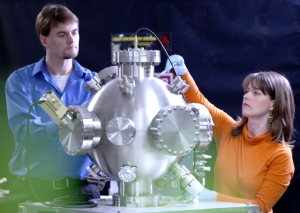US defence technology firm Lockheed Martin Corp says in a press release that it has made major technological advances in developing a power source based on nuclear fusion.

The first reactors, small enough to fit on the back of a truck, could be ready in a decade, Lockheed Martin says. It also claims that it has shown it can complete a design, build and test it in as little as a year, which should produce an operational reactor in 10 years.
According to 3News, Lockheed Martin says it’s also feasible that aeroplanes and ships will then have unlimited range, and within 15 years the electricity needs of cities the size of Tauranga could be served by a single 100MW fusion reactor the size of a trailer.
Nuclear fusion is the process that powers the sun and works by bringing atoms together instead of splitting them. It creates three to four times as much energy as fission and 10 million times more than burning fossil fuels.
Our colleagues at the Australian SMC collected the following expert commentary. Feel free to use these quotes in your reporting. If you would like to contact a New Zealand expert, please contact the SMC (04 499 5476; smc@sciencemediacentre.co.nz).
Professor Stephen Lincoln, professor of chemistry at the University of Adelaide, comments:
“Since the 1950s fusion power has been of great interest since it in principle promises unlimited energy through imitating the process which powers the sun. This process involves the fusion of the nuclei of deuterium and tritium (which are heavy versions or isotopes of hydrogen) to produce a helium nucleus and a neutron and energy. To achieve this, an enormous amount of heat and/or pressure is required – as at the centre of the sun. This is also achieved in the hydrogen bomb.
“However, to release this fusion energy in a controlled way, as required for a source of usable energy, is much more difficult. It has been achieved in a very small way in a variety of experiments, but so far there is a major snag – the amount of energy required to cause the fusion of the deuterium and tritium nuclei is greater than the energy released. Clearly, under these conditions nuclear fusion it not a viable source of energy. It is unclear from the Lockheed announcement as to whether this very major problem has been overcome. If it has, this would be a remarkable achievement.”
Professor Roger Dargaville, a research fellow and leader of the MEI Energy Futures Group at the University of Melbourne, comments:
“In moving towards a low carbon energy system, necessary to avoid dangerous climate change, it is important to consider all options. Nuclear energy is low carbon, and will be an important part of the electricity generation fleet in various countries around the world where other low carbon alternatives are not viable.
“The potential for the use of fusion reactors over fission is exciting news as the dangerous by-products of fission reactors are a major disadvantage of the technology. In the case of Australia however, it is unlikely the nuclear energy, fission or otherwise, will be cost competitive against wind and solar given the quality of renewable resources available. The lack of political will to address the general resistance to nuclear power within the population means the option for using nuclear will come too late.”
Dr Joel Gilmore, Principal of Renewable Energy & Climate Policy at ROAM Consulting, comments:
“Certainly, I’d welcome fusion as part of the world’s energy mix, but this announcement is a long way from a working prototype, let alone a commercially viable power generator. Fusion requires incredibly high temperatures and pressures, which is challenging, and a lot of people have been working on fusion for a long time. So I won’t get too excited yet.
Even if successful, the big question is what will fusion power cost? It will be challenging to compete with the falling costs of conventional renewable energy sources, especially in Australia with our world class wind and solar resources.
Certainly, today’s announcement shouldn’t be seen as an argument to delay transitioning away from fossil fuels (perhaps in anticipation of future breakthroughs); multiple studies have shown we already have the technologies required to switch to renewable energy.”